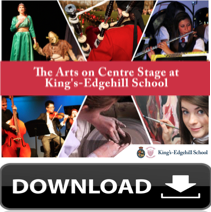 Grade 11 student, Mitchell Larkin is a fine musician. As our concerns of COVID prevent us from having School ensemble rehearsals for the time being, it doesn't stop Mitchell from maintaining a rigourous daily practice schedule. He plays the oboe in the Nova Scotia Youth Orchestra, and he has been invited to play in the National Youth Band of Canada again, once it gets up and running post COVID restrictions. Recently, he managed to acquire a Cor anglias, more commonly known as English horn. This instrument is very expensive. Even a cheap one is well over $5000, so you can only imagine what a professional model might cost. This prevents most people from getting the chance to play one. Mitchell has impressed them at the Dalhousie University Fountain School of Performing Arts, and they have loaned him a quality English horn in the hope that he will decide to study there upon graduating from KES. Being able to double will improve his odds of landing a career as a double reed specialist in a professional orchestra after university.
Grade 11 student, Mitchell Larkin is a fine musician. As our concerns of COVID prevent us from having School ensemble rehearsals for the time being, it doesn't stop Mitchell from maintaining a rigourous daily practice schedule. He plays the oboe in the Nova Scotia Youth Orchestra, and he has been invited to play in the National Youth Band of Canada again, once it gets up and running post COVID restrictions. Recently, he managed to acquire a Cor anglias, more commonly known as English horn. This instrument is very expensive. Even a cheap one is well over $5000, so you can only imagine what a professional model might cost. This prevents most people from getting the chance to play one. Mitchell has impressed them at the Dalhousie University Fountain School of Performing Arts, and they have loaned him a quality English horn in the hope that he will decide to study there upon graduating from KES. Being able to double will improve his odds of landing a career as a double reed specialist in a professional orchestra after university.
Chatting with Mitchell the other day, he brought to my attention a variety of countries that have instruments named after other nations. I have asked him to demo his new acquisition and to share his story about the horn names as well. Interesting indeed.
Please click here to watch Mitchell's video.
Exploring the English Horn
Grade 11 KES Student, Principle Oboe - Nova Scotia Youth Orchestra, Second Oboe/English Horn - National Youth Band of Canada 2021
“The English Horn has an endearing quality, which is that it’s not perfect, much like the human voice. Other orchestra instruments can be very technical, very meticulous. The English Horn is not like that (…) this is perhaps the reason composers love it so much; it’s something exotic, something you can’t quite put your finger on.” - Pedro Diaz, Metropolitan Opera Orchestra.
I chose Pedro’s quote to open this article as I think it best suits the experience I've had with the English Horn as an instrument. Being an oboist, you can become very tied up in the exact sciences that are reed making, perfect intonation, advanced articulations... It’s all rather tiresome. Little known fact, with the skills gained from playing the oboe well, one is at once capable of playing the English Horn. They are members of the same instrument family and are based on the same principles of playing, only varying in physical size and pitch. This goes as far as the fingerings being completely identical, and the range of the instrument being very similar albeit tuned down a perfect fifth. In many ways, the English Horn is the cheat instrument of the wind section; you can play it in the same concert as oboe without ever being tasked with transposing the music mentally. Your only concerns as an English Horn player are to a) have an instrument that works, and b) efficiently switch between the oboe and English Horn without interfering with the music. Dalhousie University, (by way of my teacher Suzanne Lemieux) has graciously lent me their English Horn for this orchestra season. This has given me a chance to explore the characteristics of the instrument and practice trading between oboe and English Horn in rehearsals with my ensemble. Overall, I’ve noticed a clear trend since day one, which is that the oboe is an unforgiving beast of an instrument. Behind the beautiful singing lines, the oboe is a finicky and difficult instrument in all regards. As such, I’ve begun using the English Horn as an end of practice escape from the woes of the oboe. The oboe’s struggles in the low register are nearly terminated by the English Horn’s larger reeds. The oboe’s notorious instability of pitch when starting the air to play is easily put to rest by the English Horn’s soft and swell-like attack. This trend continues to everything short of larger dynamics and high-register playing as the English Horn struggles to play loud or high as a result of its larger bore. In the end, I love them both. I’m an oboist through and through and such is the nature of being in the oboe family. That being said, the English Horn supplies a lovely departure from the typical oboe sound and is good fun to play any time a composer calls for it.
I hope you will enjoy this video I’ve compiled demonstrating a quick range comparison and some famous orchestra solos for the oboe and English Horn. Also, be sure to stay tuned to event postings in the Halifax area, as the NSYO is currently in rehearsals for what is sure to be an exciting first post-COVID concert. Socially distanced, of course! Mitchell Larkin
